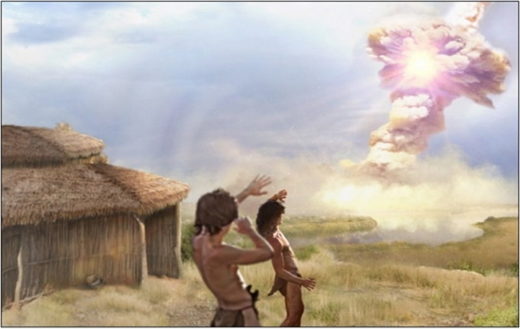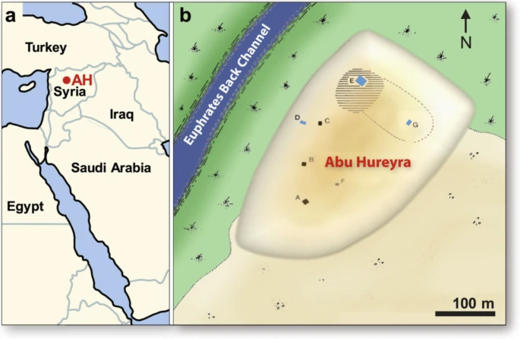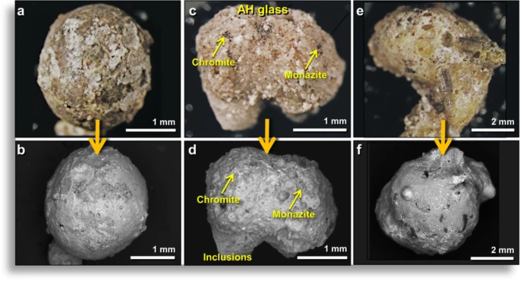Researchers find evidence of a cosmic impact that caused destruction of one of the world’s earliest human settlements
Sonia Fernandez
The Current
Fri, 06 Mar 2020 19:59 UTC

An artist impression of a cometary impact
Before the Taqba Dam impounded the Euphrates River in northern Syria in the 1970s, an archaeological site named Abu Hureyra bore witness to the moment ancient nomadic people first settled down and started cultivating crops. A large mound marks the settlement, which now lies under Lake Assad.
But before the lake formed, archaeologists were able to carefully extract and describe much material, including parts of houses, food and tools — an abundance of evidence that allowed them to identify the transition to agriculture nearly 12,800 years ago. It was one of the most significant events in our Earth’s cultural and environmental history.

Sediment samples from Trenches D, E, and G (blue rectangles) contain abundance peaks in YDB proxies, including spherules5, nanodiamonds12, meltglass8, and platinum.
Abu Hureyra, it turns out, has another story to tell. Found among the cereals and grains and splashed on early building material and animal bones was meltglass, some features of which suggest it was formed at extremely high temperatures — far higher than what humans could achieve at the time — or that could be attributed to fire, lighting or volcanism.
“To help with perspective, such high temperatures would completely melt an automobile in less than a minute,” said James Kennett, a UC Santa Barbara emeritus professor of geology. Such intensity, he added, could only have resulted from an extremely violent, high-energy, high-velocity phenomenon, something on the order of a cosmic impact.
Based on materials collected before the site was flooded, Kennett and his colleagues contend Abu Hureyra is the first site to document the direct effects of a fragmented comet on a human settlement. These fragments are all part of the same comet that likely slammed into Earth and exploded in the atmosphere at the end of the Pleistocene epoch, according to Kennett. This impact contributed to the extinction of most large animals, including mammoths, and American horses and camels; the disappearance of the North American Clovis culture; and to the abrupt onset of the end-glacial Younger Dryas cooling episode.
The team’s findings are highlighted in a paper published in the Nature journal Scientific Reports.
“Our new discoveries represent much more powerful evidence for very high temperatures that could only be associated with a cosmic impact,” said Kennett, who with his colleagues first reported evidence of such an event in the region in 2012.
Abu Hureyra lies at the easternmost sector of what is known as the Younger Dryas Boundary (YDB) strewnfield, which encompasses about 30 other sites in the Americas, Europe and parts of the Middle East. These sites hold evidence of massive burning, including a widespread carbon-rich “black mat” layer that contains millions of nanodiamonds, high concentrations of platinum and tiny metallic spherules formed at very high temperatures. The YDB impact hypothesis has gained more traction in recent years because of many new discoveries, including a very young impact crater beneath the Hiawatha Glacier of the Greenland ice sheet, and high-temperature meltglass and other similar evidence at an archaeological site in Pilauco, located in southern Chile.
“The Abu Hureyra village would have been abruptly destroyed,” Kennett said. Unlike the evidence from Pilauco, which was limited to human butchering of large animals up to but not younger than the YDB impact burn layer, Abu Hureyra shows direct evidence of the disaster on this early human settlement. An impact or an airburst must have occurred sufficiently close to send massive heat and molten glass over the entire early village, Kennett noted.

Typical examples of Abu Hureyra (AH) meltglass
The glass was analyzed for geochemical composition, shape, structure, formation temperature, magnetic characteristics and water content. Results from the analysis showed that it formed at very high temperatures and included minerals rich in chromium, iron, nickel, sulfides, titanium and even platinum- and iridium-rich melted iron — all of which formed in temperatures higher than 2200 degrees Celsius.
“The critical materials are extremely rare under normal temperatures, but are commonly found during impact events,” Kennett said. According to the study, the meltglass was formed “from the nearly instantaneous melting and vaporization of regional biomass, soils and floodplain deposits, followed by instantaneous cooling.” Additionally, because the materials found are consistent with those found in the YDB layers at the other sites across the world, it’s likely that they resulted from a fragmented comet, as opposed to impacts caused by individual comets or asteroids.
“A single major asteroid impact would not have caused such widely scattered materials like those discovered at Abu Hureyra,” Kennett said.
“The largest cometary debris clusters are proposed to be capable of causing thousands of airbursts within a span of minutes across one entire hemisphere of Earth. The YDB hypothesis proposed this mechanism to account for the widely dispersed coeval materials across more than 14,000 kilometers of the Northern and Southern Hemispheres. Our Abu Hureyra discoveries strongly support a major impact event from such a fragmented comet.”
Research on this study was conducted also by Andrew Moore, from the Rochester Institute of Technology in New York; William M. Napier, from the Armagh Observatory and Planetarium in Norther Ireland; Ted E. Bunch and James H. Wittke, from Northern Arizona University; James C. Weaver, from Harvard University; Malcolm LeCompte and A. Victor Adedji, from Elizabeth State University in North Carolina; Paul Hackley, from the United States Geological Survey; Gunther Kletetschka, from the Czech Academy of the Sciences, Charles University in the Czech Republic and University of Alaska; Robert E. Hermes, from Los Alamos National Laboratory (retired); Joshua J. Razink from the University of Oregon; Michael Willam Gaultois, from the University of Liverpool in the UK; and Allen West, from the Comet Research Group in Arizona.

Martin comments: While the mounting evidence suggests he was essentially correct, there’s still no acknowledgement for Velikovsky (author of Worlds In Collision and Earth In Upheaval). Velikovsky faced tremendous ridicule from academia when he wrote his books. Now the same academia seem to have conveniently forgotten him. Typical.

Get your copy from our Online Store or your local book and magazine retailer
Australian Retail Locations » Uncensored Publications Limited
New Zealand Retail Locations » Uncensored Publications Limited
As censorship heats up and free thought becomes an increasingly rare commodity, we appeal to our readers to support our efforts to reach people with information now being censored elsewhere. In the last few years, Uncensored has itself been censored, removed from the shelves of two of our biggest NZ retailers – Countdown Supermarkets and Whitcoulls Bookstores – accounting for 74% of our total NZ sales.
You can help keep the Free Press alive by subscribing and/or gifting a subscription to your friends and relatives.









CG
That’s a brief and cryptic comment?!